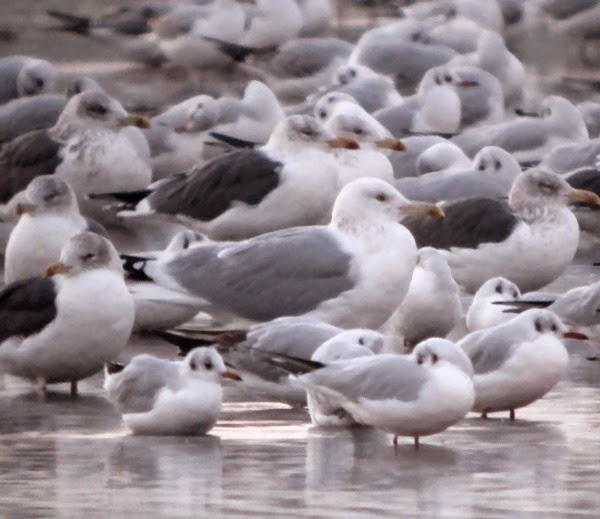So it's that time of year again. It's been a funny old year on Port Meadow this year. There are two main yardsticks that I use for measuring the Patch birding: the Year List and the Rare Count. The Year List has been rather a disappointment with a modest total of 125, well below the 130+ that we usually manage. There have been some notable non-sightings this year with Greenshank and Grasshopper Warbler being the most obvious two. Indeed it was a very poor year for waders: after all we only got our Ruff year tick in December and we never got any of those harder wader species like Sanderling, Turnstone or Spotted Redshank. We were also rather deficient on the Owl front with no sightings of either Barn or Little this year. As far as Gulls were concerned we managed most of the rarer species with just Glaucous being missed out. We even got Kittiwake this year which is a very rare bird for the Patch.
As far as Rares goes we can't really complain. Usually if I get a couple of nationally good birds on the Patch then I'm happy and this year we had Glossy Ibis (a Patch first), Spoonbill (pretty much annual) and Great White Egret (another Patch first) though the latter was only reported on RBA. However there was a GW Egret knocking around the county for much of the summer so I can well believe that one flew over Port Meadow air space.
So looking in more detail, what have been the highlights of the year? We started the year with the floods in full Lake Mode. January was pretty much what you'd expect with a Jack Snipe probably the highlight. February saw the floods still very extended with a Kittiwake and a Red-crested Pochard the pick of the birds. In March, as the floods finally started to get back to their usual size, it was all about the gulls with several Caspian, Iceland and Mediterranean Gulls all seen. Adding a touch of the exotic was also an escapee Cape Shelduck that hung out with an increasingly large Shelduck Flock. The first spring migrants, a couple of Little Ringed Plovers, didn't arrive until the 24th, very late this year.
 |
| 3w Caspian Gull |
 |
| Iceland Gull |
April saw the spring migrants arrive in force. That month there was also a White-fronted Goose (of unknown origin that I ended up not counting on the year list), a Little Gull and a drake Garganey. We also had the last of the winter gulls with another Iceland Gull, a Tree Pipit in Burgess Field (a good bird for Oxon) and the first of the Rares in the form of a Spoonbill that sadly only spent a few minutes on the floods before being flushed.
 |
| This was the only Spoonbill in the whole county this year |
 |
| Glossy Ibis (c) Pete Roby |
 |
| The May Avocet |
The only birds of note in June were a couple of fly-over Green Sandpipers, normally quite tricky birds to get on the Patch so I was pleased to see them. July too was pretty birdless and I spent my time getting to know the local flowers instead. With the floods firmly dried up, in August it was up to the passerines to try and produce something of interest. We managed several Common Redstart sightings and also a pair of Whinchat and a Spotted Flycatcher - all good birds for the Patch. August did produce the third Rare of the year in the form of a Great White Egret that was reported flying over the A40 towards Port Meadow mid month. September and October were just as tough going with a Tree Sparrow in a garden in Wolvercote the pick of the birds. Towards the end of October the floods started to reform though for a while they were still rather small.
It wasn't until November that the floods regained their full size and with the extra water came back some decent birds. As well as regular sightings of Yellow-legged Gulls there were a couple of Caspian Gulls: a 1w bird and a smart adult. A Short-eared Owl in Burgess Field was a welcome find one afternoon and there was also a remarkably showy Jack Snipe out in the open on the floods one day. This month all the winter birds came back in force and there were good counts of all the usual winter species. This theme was continued into December with plenty of birds though not much variety. The pick of the birds in December was a Ruff which finally made it onto the Year List.
 |
| Adult Caspian Gull |
On the moth front the most notable catches were firstly a tiny fern-loving micro called Psychoides filicivora, only the third ever record for the county which I caught in my garden in May. Secondly was a Toadflax Brocade which is technical a national rarity though it's rapidly colonising new areas. It was however the first record for the VC23 recording area so a nice recoding area first for my garden.
 |
| Psychoides filicivora |
 |
| Toadflax Brocade |
So there you have it. My general feeling looking back on the year was that it was hard work: with the floods absent for a good proportion of the year and with a very poor spring wader passage throughout the county there was a lot of slogging around for little reward. Still that is what Patch birding is all about and there's always something of interest to look at and learn about. I'm going to give the Patch Bird of the Year award to the Glossy Ibis as it was the first record for the Patch.
Finally it only remains for me to wish all my readers a Happy and Bird-filled New Year.








































